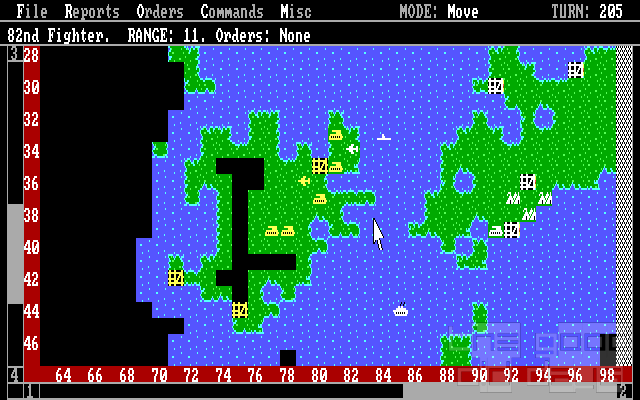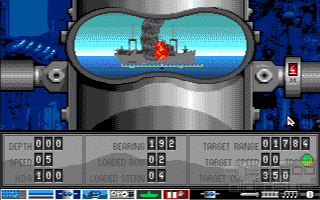There isn't a lot of modesty in a title such as Wargame of the Century. Though in the commercial computer gaming industry, which by 1987 had not even hit 15 years, it was a big deal to release a game with a history almost that long.

The history of Empire bears some similarity with a few other games from the mid to late 1970s. At least those which became enduring classics with a significant legacy such as this one. Originally developed on and for a university mainframe, it quickly gained popularity within student and staff circles… eating up considerable resources of this time-sharing system. Though where certain contemporaries took the plunge and founded their own companies, such as Infocom, Empire author Walter Bright got a “real” job in his original field – engineering.
Fast-forward ten years, and two half-baked attempts at selling different ports from his home later, he reconsidered. A real publishing company was needed to reach a bigger audience. The big names of the time – such as Epyx and Microprose<a name=“ref1” href=“#fn1”>¹</a> – passed on it, however. Most citing being unimpressed with its lack of graphics. Finally, it was Interstel who showed interest.

Interstel, ironically, was one of those companies formed exclusively to market a university mainframe game: Star Fleet. Hardly a powerhouse in the publishing business, it had made its niche, and thematically proved a good match. Like Star Fleet, Empire was firmly placed within the wargaming genre. Neither game attempted to generate depth through an abundance of options or features, but rather relied on a basic set up rules easily understandable. For marketing reasons, Interstel even claimed Wargame of the Century (the subtitle added for the commercial version) to be set in the Star Fleet universe. Calling it the “planet invasion module”.
Which was, however, never more than a marketing link. In fact, Empire is firmly set in Earth's reality and history. Simulating a war strongly reminiscent of the Pacific theatre of World War II: the focus being on navy operations and island hopping. The available military units representing the state of technology of said World War II: battle ships, cruisers, destroyers, submarines, transports, aircraft carriers, fighters and armies.
The randomised, initially unknown maps are populated with cities which produce such military units. The only resource available and needed is time. The more powerful a unit, the longer it will take to produce. Planning well ahead is necessary when commissioning a mighty battleship. The key to win lying in the logistical challenge to have the right units available in the right place at the right time. All coordinated perfectly, to strike at the heart of the enemy territory with lethal effectiveness and efficiency.

On the other hand, unescorted transports are easy prey to the enemy fleets. Losing which equals double punishment: not only the expensive ships are destroyed, but also the armies on board. Armies are a necessity to conquer cities, but they don't contribute much to the overall strategic superiority game. Shore bombardment by the heavier class ships makes short work of them.
Unlike the typical SSI wargames of the time, Empire derives its complexities from few basic rules. Units don't have a lot of stats. As listed, there aren't a whole lot of different unit types in the first place. The seas don't allow for any different terrain, and land is just plain land, too. Aircraft are mainly good for reconnaissance. Only the submarines bring some unforeseen and difficult to predetermine fuzziness into the game, with their special visibility rules and particularly destructive offensive capabilities. Indeed allowing to turn a seemingly lost game around with some luck.
Rather, Empire is one of the first games of emerging complexity. Its depth not being in the difficult to oversee rules, but in the optimisation of using the available means and resources best. When playing against other human players, in the psychology of guessing where the other player may throw their forces to.
For its commercial release, Interstel tasked employee Mark Baldwin to add a graphical layer and a mouse-driven interface to the game. While not spectacular to look at even after this facelift, it proved quite a successful approach nevertheless. The high resolution gives good overview of the battlefield. The original modal keyboard interface has been retained; the click-operated menus serve as an additional, optional layer on top. Triggering the same functions, allowing easier discoverability of what the already previously powerful interface is capable of. This way, new players can learn the basics without much effort and later graduate towards the obviously much more efficient keyboard controls… which surely and admittedly is a necessity when moving a force of several dozen army units from one island to another without going crazy.

Small technical weaknesses, pathfinding being the most apparent among them, easily forgiven, the turns just pass by like nothing. Using terminology invented much later, Empire was the original just one more turn game. There is always something to do. Just one more city which just became visible to conquer. Just few more squares into the unknown. Just destroy this one enemy cruiser. And suddenly, the night is over without having slept for a single minute.
Though staying with modern-day standards, the game does suffer from two things. First, it could serve as dictionary illustration for the long endgame. At some point, it is inevitable who will be the winner. And yet, the game goes on. For hours in the worst case. Second, in spite of a few really handy automation functions, there is a lot of micromanagement to be performed. Moving every single unit by hand, every turn. Keeping in mind exactly the big plan one made. The relation between taking interesting decisions and mindlessly executing them is off.
The latter term, describing games as a series of interesting decisions, has been coined and popularised by Sid Meier. The very same Sid Meier who a couple of years later designed Civilization. A huge game, the series going strong to this very day, which not only looks like, but overall owes a lot to Empire. And shares many of its strengths and weaknesses. Seems like even the awareness of such game design standards doesn't make them all that easy to fulfil, or avoid the less desirable sides.

Regardless, Empire has aged not too badly. The wargaming genre in general being very niche these days, it remains immensely more playable than most of its contemporaries (whether talking of 1977 or 1987, it doesn't matter). The easy to grasp concept and rules, the intuitive interface, the basic, but well-recognisable graphical representation of things… it feels modern enough in many respects.<a name=“ref2” href=“#fn2”>²</a>
Which is ironic to a degree, considering how its genesis is the antithesis of modern-day software development. Its core, the game itself with its features, its rules, having been tweaked, tested and matured over a long time before then putting some accessibility layers on top and taking it on the market. Whereas these days, everything seems to be just about flashy appearance first while getting what should be the actual functionality to just a “barely presentable” level.
Within the commercial computer game arena, Empire did receive new life six more years later in the Deluxe version. Made and published by none other than Mark Baldwin and his new company at the time – under licence from Walter Bright. Making light adaptations, quite successful ones at that. But retaining the core game, and even the interface. A testament to the original's qualities, and clearly a labour of love. Empire II: The Art of War followed, but shared very little with the original beyond the title.
<a name=“fn1”>[1]</a> Walter Bright unfortunately does not recall whether he offered the game to SSI, kings of computer wargaming at the time. <a href=“#ref1” style=“text-decoration:none”>↑</a>
<a name=“fn2”>[2]</a> For those who feel inclined to give it a try, Walter Bright maintains a website offering various free-to-download versions of his game. <a href=“#ref2” style=“text-decoration:none”>↑</a>


Comments (2) [Post comment]
I remember this one, and the classical music at the title screen.I was terrible at it (let's just say it was because of my age) and considered it just a worse Civilization.
Posted on Mastodon